I have always loved fishing and like to think that I’m pretty good at it. After all, fishing has been my job and my passion for more than 30 years. When I was diagnosed with cancer, and then again when I was given a permanent colostomy, I feared I would lose this essential part of me.
However, in the end, the desire to get back to something I love helped me hold on through illness and operations. After that, fishing trips with friends that have put me on the path to recovery, helped me come to terms with my situation and allowed me to live an active and adventurous life with a stoma.
Troubled waters
I found a bump, and my wife insisted I get checked out. At first, we thought it was just a small hernia. We expected a simple operation, followed by a couple of days off work, a little milking of the situation and then back to normal.
It didn’t quite work out like that. The next morning, the doctor came, held my hand and asked the kids to leave the room. It all felt eerily like a soap opera, and then it came. All I took from the doctor’s long and sympathetic words were ‘cancer’, ‘lose organs’ and, thankfully, ‘prognosis pretty good’.
It was a rare abdominal cancer known as pseudomyxoma peritonei. I found out why it is sometimes called ‘jelly belly’ cancer when the surgeons, in a scene straight out of the film Alien, removed a lot of slimey liquid, known as mucin. Fortunately, the cancer starts in the appendix, an organ whose function is not exactly clear, which meant that it could be surgically removed without any noticeable changes in how my body worked. After the operation, to make sure the cancer was gone, I was parboiled with warmed-up chemotherapy, followed by 5 days of my belly being turned into a chemo milkshake.
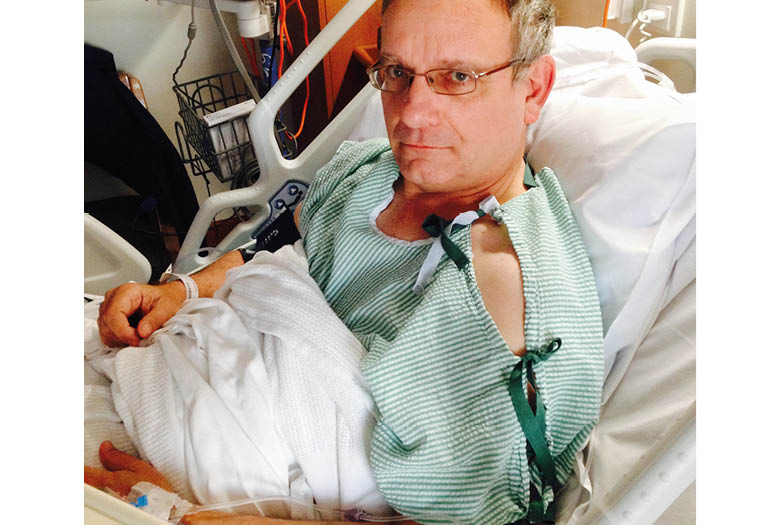
Frank has had six operations for cancer
A difficult catch
The cancer can spread to the surrounding bowel. Therefore, before the operation, I had two ominous black dots painted on my belly, in case I ended up with so much bowel removed that I needed a colostomy. This frightened me more than anything else; I did not want to become a bag man.
Pseudomyxoma peritonei also has a habit of coming back, and this ended up happening to me five whole times. Each time I woke up after surgery, the first thing I did was lift the blankets. The first five times, I was extremely relieved to see both black dots still there. I could go back to the tough job of beating this thing.
The sixth operation began with a different sort of conversation. The surgeons described a tumour in my lower abdomen the size of a softball. They hoped it hadn’t compromised anything important, but there was a good chance that I would lose my bladder. It was likely that I would need a stoma, although this would hopefully be reversible.
This prepared me for what I saw when I lifted back the covers: no black dots, just an unsightly, skin-coloured pouch. Before I had time to worry about this, I was informed that I also had holes in my ureters (the tubes that ran from my kidney to my bladder). I was in hospital in Sydney for months, something like a medical pincushion, while I slowly got back some strength and energy.
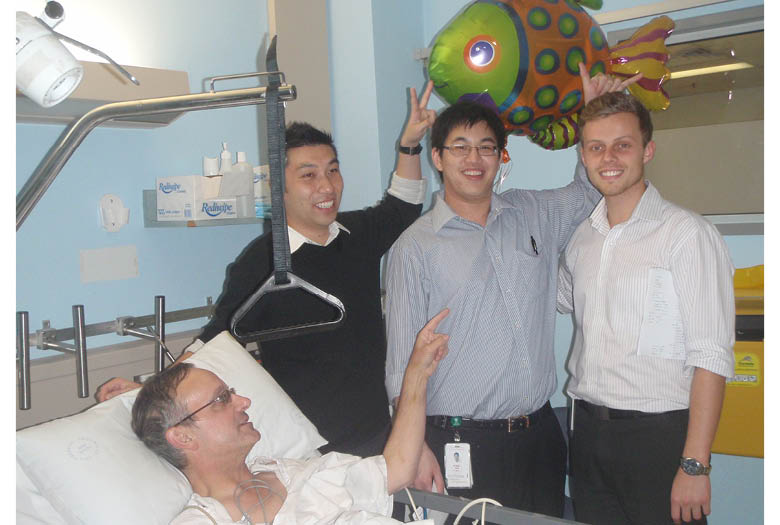
Fishing was never far from Frank’s mind
Putting it back
When I was finally allowed to fly home to Perth, I had no fewer than five bags attached to my person. I needed a bag to carry all of my bags! This meant coming to terms with the fact that I was a bag man. It was a set of events that most men would not react well to, myself included. An excuse for making fart sounds in mixed company was small consolation. Therefore, I pinned my hopes on a reversal, learning from the experience and being able to go back to normal.
However, this wasn’t to be. The rectal stump had deteriorated and couldn’t be reattached, and so I was a bag man for life. Still, I wasn’t going to give up, and I was determined to make the best I could of the situation. This became a matter of getting back what I loved most. The question that stayed with me, through the darkest days of morphine dreams and chemotherapy, was whether I would be able to keep fishing.
With my doctors’ encouragement, I started to get back on the water. I was lucky to be helped by my good mate Murray, who happens to have an ileostomy himself. Murray was a brave and wonderful inspiration to me to get up and get out there. We began slowly, first bait fishing for bream from a small boat, and then gradually building up to longer and more challenging trips. It was wonderful!
Holding tight |
|
After I had started going back fishing, I spoke to a nurse from the Western Australia Ostomy Association. The nurse asked how I found wearing the support garment while I was out, and I had to confess that I wasn’t aware that I needed one. I was soon educated, and it turned out I was lucky that pulling in fish or carrying a canoe did not result in a hernia. Now, whenever undertaking any kind of strenuous activity, I always wear a support garment. |
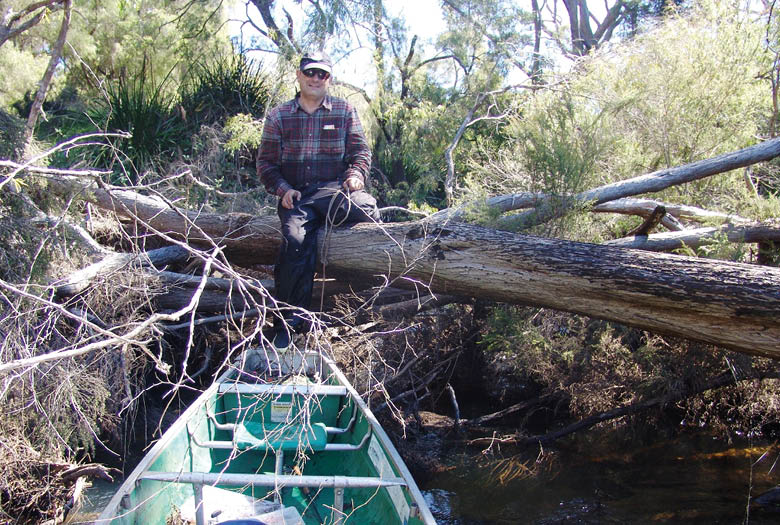
Sometimes you have to carry the canoe
Lifeline
Eventually, Murray and I got back to one of my favourite activities—fishing for redfin perch in the southwest of Western Australia. These trips are not for the faint-hearted. Not only do they involve venturing beyond mobile phone coverage and into rugged bush country (or ‘tiger country’, as Australians call it), we often have to get out of our canoe to drag it from snag to snag or lift it over the massive logs of fallen jarrah and karri trees. Throughout the course of day, this becomes more difficult, as our portable cooler fills up with redfin (they are far too good to eat to go back in the river) and grows heavier and heavier. This is a true test of stamina, but it’s only when you’re in the gnarly stuff that you’re really catching fish.
It was on one of these trips I had one of my more difficult moments. As usual, Murray and I were having an amazing time, when we stopped for lunch—a sandwich and an apple. Murray suggested that it was a good idea for people in our condition to peel their apples before eating them. With a certain male stubbornness, I told Murray not to worry and munched mine with the skin still on. After we had set off, I started getting some unpleasant twinges, which gradually became cramps. By the time we reached a bridge where we could exit, I was in extreme pain. I ended up spending 3 days in Pemberton Hospital, where they found and fixed a bowel obstruction. It was a lovely hospital, and I hope to never need it again. Needless to say, apple peel is off the menu!
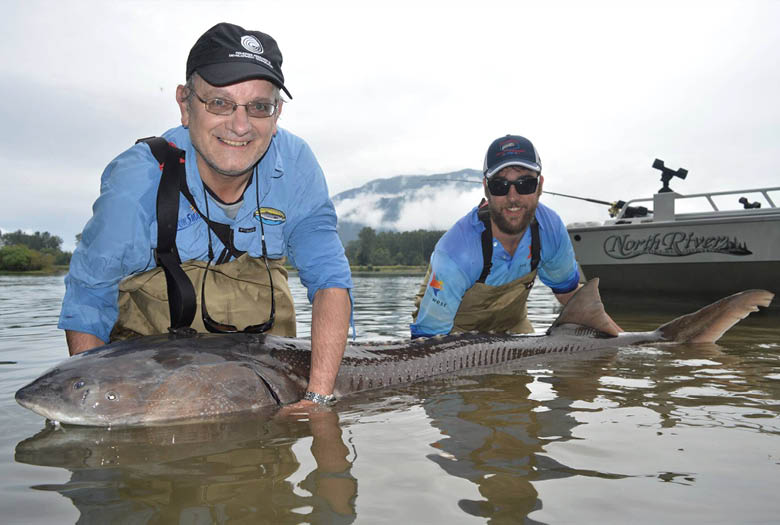
Some fish are bigger than others
Bigger fish to fry
My favourite place in the world to fish, relax and enjoy is New Zealand, and having a stoma hasn’t stopped me from getting out there as often as I can. I love everything about the place, from the huge trout and amazing water to Speight’s beer and the lack of snakes. I’ll even admit they have better meat pies than at home in Australia.
My experience of illness has taught me to make the most of friendships. I have two old friends: Bill Classon, who is editor of the magazine Freshwater Fishing Australia, and Nigel Webster, who is the host of a fishing show on Australian television. It had been far too long since we’d fished together, so I got on the phone and begged, cajoled and probably threatened them to come with me for a fish on New Zealand’s South Island. Lured by the prospect of a world-class fishery full of 9+ kg trout, they came for a mind-blowing trip together.
So good was the fishing that it was covered in print and on television. I was on camera when I lost a giant 14 kg trout, but that was more than made up for when I landed an even larger 15 kg fish from a canal near Twizel. To put into context how special this was: each year, literally millions of brown trout are caught around the world, on all continents except Antarctica, and probably no more than a hundred or so are of that size. I was really stoked. The ultimate sense of satisfaction and fulfilment came when I watched that massive, beautiful brown trout swim back into the canal. It felt as if all of my hard work in hospital had been worth it, and being able to share that incredible moment with good friends beside me was so very special. It could only have been more perfect if my family were there.
There was a moment on this trip that really showed how friends can help overcome the challenges of having an ostomy. We were making our way up the Hawea River to a spot where had I assured the boys that there were good fish to be had. Nigel had stopped to get some extra footage for television and was getting ready to record a to-camera shot about fishing in stronger current. I was behind the others when I tripped over a rock. As I fell, my pouch was caught, and the seal with the skin was broken. This is the kind of moment that every ostomate is wary of—we worry a leak can be as socially embarrassing as it is physically challenging. However, Bill and Nigel showed real patience and understanding while I composed myself. I’d planned and packed for this eventuality, so everything was soon fixed, and within 20 minutes the camera was rolling. The on-air segment didn’t give a hint of the drama behind the scenes.
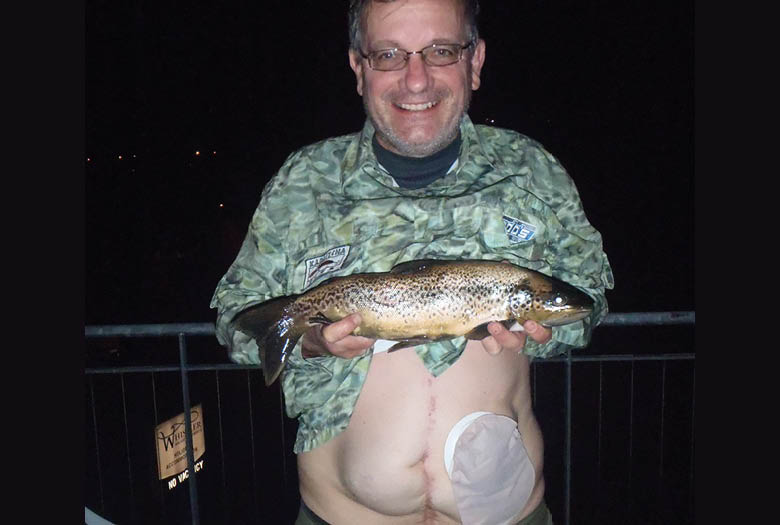
Ostomates can enjoy the outdoors
Net results
In 2018, I had the honour of leading a group of Australia’s brightest young fishing leaders to Canada for the World Recreational Fishing Conference. I am a great believer that empowering and supporting the next generation through adversity can help them avoid the mistakes of the past. I think this applies to living with a stoma as much as it does to fishing.
As part of the trip, we joined an investigation into the white sturgeon. The species had been pushed to the brink of extinction in pursuit of their eggs for caviar, and they had only begun to recover thanks to a partnership between anglers, scientists and local communities, including first-nation peoples. My scars and stoma were well and truly tested when I caught and then released a 229 cm, 105 kg fish. The fish had been tagged 5 years previously, and understanding its growth and movement helped contribute to the conservation of this species.
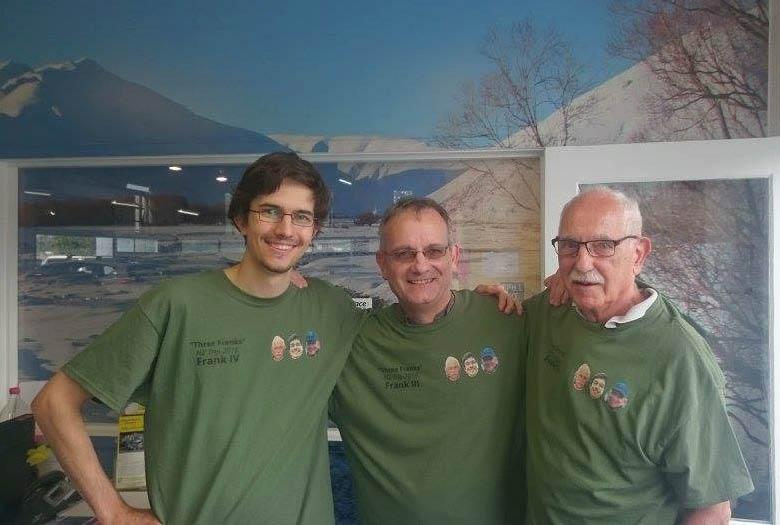
Frank with his dad and his son—family can help you back on your feet
Teach a man to fish
Each of these trips has been a wonderful experience. I don’t think that the people I shared them with can realise just how important they’ve been to me. It was trips like that kept me focused when I was sitting in a hospital bed, with upwards of 10 tubes coming out of my body, filled with chemo, in serious pain and feeling miserable. When you are chundering into a nasogastric tube, you need a good distraction!
Every day, there are many people facing bigger struggles than mine. I believe that in life we can only do our best to play the hand we are dealt and get on with it. I was certainly helped by the support of wonderful friends and family. It was also the thought of being able to do something that I love that kept me going.
As each tube was removed and my strength slowly returned, I found I could gradually resume my old recreational activities. It was the companionship and encouragement of friends, as well as my focus on a favourite activity, that allowed me to overcome adversity to recover and regain an active life, where I can enjoy the outdoors without feeling limited by having a stoma.
Frank Prokop lives in Western Australia and works in fishery management and research

